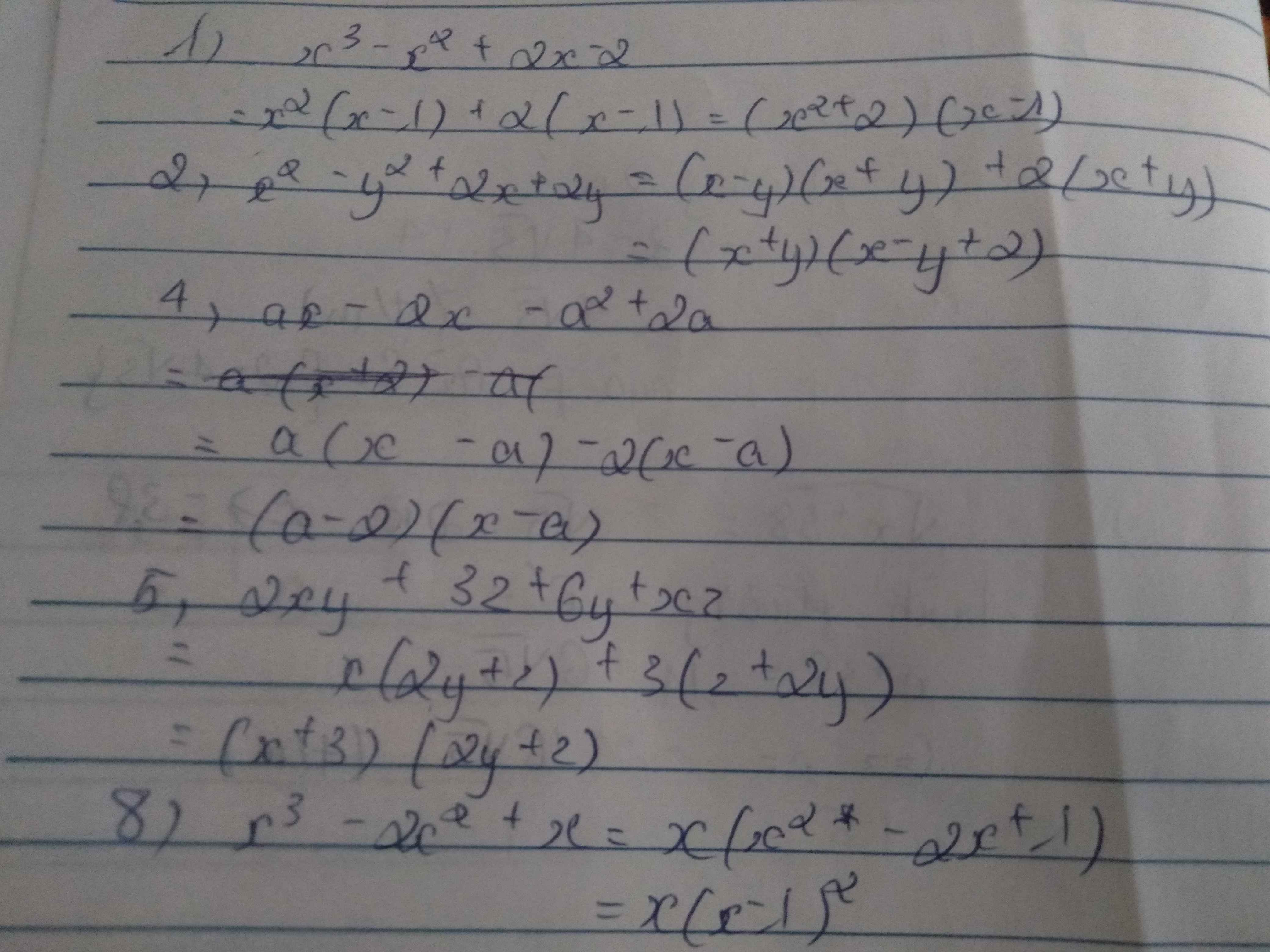2X\(\dfrac{4}{6}X3=\)
Hãy nhập câu hỏi của bạn vào đây, nếu là tài khoản VIP, bạn sẽ được ưu tiên trả lời.


\(\frac{3}{4}+\frac{1}{2}+\frac{3}{2}=\frac{3}{4}+\frac{2}{4}+\frac{6}{4}=\frac{3+2+6}{4}=\frac{11}{4}\) em nhé.
\(\dfrac{3}{4}+\dfrac{1}{6}\times3+\dfrac{2}{5}:\dfrac{4}{15}\)
\(=\dfrac{3}{4}+\dfrac{1}{2}+\dfrac{2}{5}\times\dfrac{15}{4}\)
\(=\dfrac{3}{4}+\dfrac{1}{2}+\dfrac{3}{2}\) \(=\dfrac{3+2+3}{4}=\dfrac{8}{4}=2\)

a: =>5/42-x=11/13-15/28+11/13=421/364
=>x=-1193/1092
b: =>\(\dfrac{7}{2}-2x=7+\dfrac{6}{5}-3-\dfrac{2}{5}-1-\dfrac{4}{5}=3\)
=>2x=1/2
=>x=1/4
c: =>|2x-1/3|=-1/3(vô lý)
d: =>2x-1=-3
=>2x=-2
hay x=-1
e: =>2x=16
hay x=8

1.
Đặt \(x^2-2x+m=t\), phương trình trở thành \(t^2-2t+m=x\)
Ta có hệ \(\left\{{}\begin{matrix}x^2-2x+m=t\\t^2-2t+m=x\end{matrix}\right.\)
\(\Rightarrow\left(x-t\right)\left(x+t-1\right)=0\)
\(\Leftrightarrow\left[{}\begin{matrix}x=t\\x=1-t\end{matrix}\right.\)
\(\Leftrightarrow\left[{}\begin{matrix}x=x^2-2x+m\\x=1-x^2+2x-m\end{matrix}\right.\)
\(\Leftrightarrow\left[{}\begin{matrix}m=-x^2+3x\\m=-x^2+x+1\end{matrix}\right.\)
Phương trình hoành độ giao điểm của \(y=-x^2+x+1\) và \(y=-x^2+3x\):
\(-x^2+x+1=-x^2+3x\)
\(\Leftrightarrow x=\dfrac{1}{2}\Rightarrow y=\dfrac{5}{4}\)
Đồ thị hàm số \(y=-x^2+3x\) và \(y=-x^2+x+1\):
Dựa vào đồ thị, yêu cầu bài toán thỏa mãn khi \(m< \dfrac{5}{4}\)
Mà \(m\in\left[-10;10\right]\Rightarrow m\in[-10;\dfrac{5}{4})\)
Có cách nào lm bài này bằng cách lập bảng biến thiên k ạ

a. (3x - 1)2 - (x + 3)2 = 0
\(\Leftrightarrow\left(3x-1+x+3\right)\left(3x-1-x-3\right)=0\)
\(\Leftrightarrow\left(4x+2\right)\left(2x-4\right)=0\)
\(\Leftrightarrow4x+2=0\) hoặc \(2x-4=0\)
1. \(4x+2=0\Leftrightarrow4x=-2\Leftrightarrow x=-\dfrac{1}{2}\)
2. \(2x-4=0\Leftrightarrow2x=4\Leftrightarrow x=2\)
S=\(\left\{-\dfrac{1}{2};2\right\}\)
b. \(x^3=\dfrac{x}{49}\)
\(\Leftrightarrow49x^3=x\)
\(\Leftrightarrow49x^3-x=0\)
\(\Leftrightarrow x\left(49x^2-1\right)=0\)
\(\Leftrightarrow x\left(7x+1\right)\left(7x-1\right)=0\)
\(\Leftrightarrow x=0\) hoặc \(7x+1=0\) hoặc \(7x-1=0\)
1. x=0
2. \(7x+1=0\Leftrightarrow7x=-1\Leftrightarrow x=-\dfrac{1}{7}\)
3. \(7x-1=0\Leftrightarrow7x=1\Leftrightarrow x=\dfrac{1}{7}\)

1) \(\left(\dfrac{1}{2}x+3\right)\left(x^2-4x-6\right)\)
\(=\dfrac{1}{2}x^3-2x^2-3x+3x^2-12x-18\)
\(=\dfrac{1}{2}x^3+x^2-15x-18\)
2) \(\left(6x^2-9x+15\right)\left(\dfrac{2}{3}x+1\right)\)
\(=4x^3+6x^2-6x^2-9x+10x+15\)
\(=4x^3+x+15\)
3) Ta có: \(\left(3x^2-x+5\right)\left(x^3+5x-1\right)\)
\(=3x^5+15x^2-3x^2-x^4-5x^2+x+5x^3+25x-5\)
\(=3x^5-x^4+5x^3+10x^2+26x-5\)
4) Ta có: \(\left(x-1\right)\left(x+1\right)\left(x-2\right)\)
\(=\left(x^2-1\right)\left(x-2\right)\)
\(=x^3-2x^2-x+2\)

Bài 2:
\(A=\dfrac{2}{-x^2-2x-2}=\dfrac{-2\left(-x^2-2x-2\right)-2x^2-4x-2}{-x^2-2x-2}\) \(=-2+\dfrac{2\left(x+1\right)^2}{-x^2-2x-2}\ge-2\)
Dấu bằng xảy ra \(\Leftrightarrow x+1=0\Leftrightarrow x=-1\)
Vậy \(A_{Min}=-2\) khi \(x=-1\)
Bài 1:
a) Ta có: \(2x^2-6=0\)
\(\Leftrightarrow2x^2=6\)
\(\Leftrightarrow x^2=3\)
hay \(x\in\left\{\sqrt{3};-\sqrt{3}\right\}\)
Vậy: \(S=\left\{\sqrt{3};-\sqrt{3}\right\}\)

Bài 1:
\(a,6x^2-15x^3y\\ b,=-\dfrac{2}{3}x^2y^3+\dfrac{2}{3}x^4y-\dfrac{8}{3}xy\)
Bài 2:
\(a,=20x^3-10x^2+5x-20x^3+10x^2+4x=9x\\ b,=3x^2-6x-5x+5x^2-8x^2+24=24-11x\\ c,=x^5+x^3-2x^3-2x=x^5-x^3-2x\)

\(=2\cdot\dfrac{2}{3}\cdot3=4\)
4